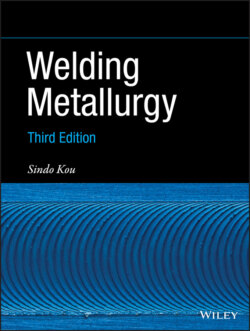Читать книгу Welding Metallurgy - Sindo Kou - Страница 70
2.2 Heat Flow During Welding 2.2.1 Response of Material to Welding Heat Source
ОглавлениеBefore proceeding to discuss analytical equations for heat flow in the workpiece, it is worthwhile to consider the response of the material in the workpiece to the welding heat source, such as the material in the heat‐affected zone (HAZ). Figure 2.14a shows the positions of a weld pool (which is moving from left to right) at three different moments of time. Let T L be the temperature at which the workpiece material melts completely during heating and T H be the temperature at which the solid‐state transformation occurs during heating. Thus, the region of the workpiece scanned by the T L isotherm (i.e. the pool boundary) is the fusion zone. The region of the workpiece scanned by the T H isotherm, excluding the weld pool and the fusion zone, is the HAZ.
Figure 2.14 HAZ thermal cycle: (a) top view of weld pool, fusion zone (solidified material behind pool) and HAZ (material next to pool and fusion zone); (b) thermal cycle recorded with a thermocouple inside HAZ during welding.
A thermocouple is prepositioned inside the HAZ. As shown in Figure 2.14b, it detects a temperature well below T H at time t 1, a peak temperature between T L and T H at time t 2, and a temperature below T H at time t 3. The temperature‐time curve experienced at a location in the workpiece during welding, such as that shown in Figure 2.14b, is called the thermal cycle. The thermal cycle of the HAZ provides information such as the peak temperature (how close to T L), the duration above T H and the cooing rate, which are useful for better understanding of the HAZ microstructure and properties. Likewise, the thermal cycle of the fusion zone, which shows a peak temperature above T L, provides information useful for studying the fusion‐zone solidification microstructure and properties.
Figure 2.15 is a schematic showing the welding of a stationary workpiece [24]. The origin of the coordinate system moves with the heat source at a constant speed V in the negative‐x direction. Except for the initial and final transients of welding, heat flow in a workpiece of sufficient length is steady, or quasi‐stationary, with respect to the moving heat source. In other words, to an observer moving with the heat source, the temperature distribution and the pool geometry do not change with time. This steady‐state assumption was first used by Rosenthal [25] to simplify the mathematical treatment of heat flow during welding.
Figure 2.15 Coordinate system (x, y, z) moving with heat source.
Source: Kou and Le [24]. © TMS.
